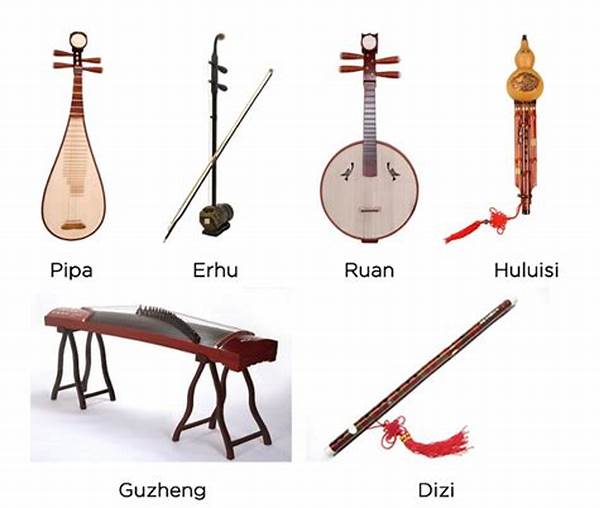Welcome to a harmonious journey where tradition meets innovation, a narrative spanning thousands of miles blending the old and the new. Let’s dive into an enchanting world where the sonorous sounds of the guzheng, erhu, and pipa waltz seamlessly with violins, cellos, and trumpets in a symphonic fusion like no other. This captivating mix of Chinese traditional music instruments and Western orchestras is not just an unusual combination; it is a compelling showcase of cultural synergy that captivates audiences worldwide. If you think orchestral music can’t surprise you anymore, brace yourself; this is something entirely different!
Read More : Digital Learning Kits With Integrated Instruments
Imagine a scene where the profound tones of a Chinese zither reverberate throughout a concert hall, and just as you are lost in its tranquillity, it merges flawlessly with a joyous crescendo of a Western symphony. You might wonder why—and how—this fusion works, why it matters, and what it means for the future of music globally. You’re not alone in this curiosity, as composers, musicians, and conductors from diverse backgrounds are passionately exploring this auditory alliance to not only entertain but educate and inspire audiences about the vast, rich tapestry of global music traditions.
Evolution of Musicianship: Bridging Cultures
In the diverse domain of music, the practice of integrating Chinese traditional instruments with Western orchestras is akin to a culinary genre arc that brings unexpected elements into a classic dish. It’s an innovative blend that showcases the unique tones of each instrument while creating a fresh, engaging listening experience.
This growing trend reflects a larger movement in the global music scene geared towards inclusivity and cultural exchange, offering musicians and listeners alike a novel way to experience music. Chinese traditional instruments bring intricate textures and historical resonance that enrich the bold harmonies of Western orchestras. By bridging Eastern and Western soundscapes, musicians are crafting a new genre that enjoys the novelty of tradition without forgoing the thrill of modern orchestration.
A Dance of Sounds: The Instruments Behind the Fusion
At the heart of this musical evolution, specific Chinese instruments have emerged as stars. The guzheng, with its 21 strings, adds a sweeping, ethereal quality. The two-stringed erhu is cherished for its deeply emotional voice, while the pipa’s distinct plucking offers a bright, lively sound. These instruments interlace to create diverse auditory tapestries, adding their own narratives to a symphonic context.
Consider the guzheng performing alongside the Western flute and violin. Its stringed echoes effortlessly blend with the wind instruments, creating mesmerizing layers of simple, yet expressive musical conversations. This experience is not just about listening; it’s an auditory adventure that invites the listener to traverse a bridge where China’s millennia-old musical traditions meet the symphonic majesty of the West.
Chinese Traditional Instruments: A Harmonious Integration
Discovering Harmony in Diversity
One might wonder how these two distinct musical cultures can coexist harmoniously in a single composition. The answer lies in the adaptability and versatility of the traditional Chinese instruments. Their ability to weave into the fabric of Western orchestral music is a testament to the universality of music itself. It’s a journey of discovering inclusion through sonic expressions.
In orchestral settings, the pipa and dizi often play counterpoints to the brass and string sections, offering a lively, dynamic edge that enhances the overall narrative—a dialogue rather than a competition. By allowing each instrument to shine within its unique voice, the integration doesn’t overshadow but complements the symphony.
Craftsmanship in Composition
The successful interweaving of such diverse musical elements requires craftsmanship and sensitivity in composition. Composers are tasked with not simply placing Chinese instruments into Western frameworks but finding intersections where both traditions can contribute equally and innovatively. It’s a delicate balance struck through shared melodic motifs, rhythmic synchronization, and dynamically balanced orchestration that allows Chinese traditional music instruments to shine alongside their Western counterparts.
Bridging the Gap: Composers’ Insight
Contemporary composers like Tan Dun and Bright Sheng have embraced this sonic fusion. They are pioneers, using their pieces to showcase the cultural amalgamations where Chinese instruments augment the emotive and narrative ambits of Western compositions.
Read More : Musical Instrument Carried By Nomads Across Deserts For Centuries
“When the erhu cries amidst the violin’s soliloquy, we witness a human tale transcending linguistic limits through pure sound,” shares Tan Dun. His insights speak volumes of the potential these fusions carry, showcasing not just musical prowess but cultural respect and exchange.
Purpose and Impact: Why This Matters
Sonic Diplomatic Relations
The marriage of Chinese traditional music instruments with Western orchestras acts as a conduit for cultural dialogue. It has become a beacon for equity in representation within global music forums, with performances that not only entertain but educate audiences about the importance of cultural intertwining.
Expanding Audience Horizons
This hybrid genre is instrumental in drawing a diverse audience base, piquing interest amongst traditionalists and modernists alike. Music listeners find themselves in a hub of cultural diversity, invited to explore unfamiliar musical terrains with the comfort of familiar symphonic backbones.
Educational Opportunities
As educational institutions incorporate these practices into their curriculum, future musicians are encouraged to think outside the box. They are educated in the universal languages of music, preparing them to contribute meaningfully to a world where musical and cultural borders continually blur.
In conclusion, the amalgamation of Chinese traditional music instruments with Western orchestras represents an evolving musical landscape that embraces tradition while venturing into uncharted auditory territories. This fusion speaks not only to a shared history and future but serves as a powerful reminder of the unity and beauty inherent in cultural and musical diversity.
Key Takeaways on Blending Cultures Through Music
The integration of Chinese traditional music instruments into Western orchestras is more than just a trend; it symbolizes an enduring spirit of global cultural coexistence and innovation. Whether you’re a musician, a composer, or an avid listener, there’s an invitation for everyone to partake in this exquisite musical journey, where every note played bridges centuries and continents.
